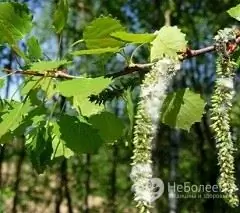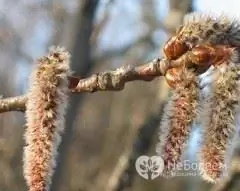- Author Rachel Wainwright [email protected].
- Public 2023-12-15 07:39.
- Last modified 2025-11-02 20:14.
Aspen
Instructions for use:
- 1. Description and distribution locations
- 2. Application history
- 3. Chemical composition
- 4. Medicinal properties
- 5. Contraindications

Aspen is a tree belonging to the Willow family.
Description of aspen and distribution site
The tree can reach a height of 30 meters, has a very extensive root system. The trunk is covered with gray smooth bark, wood is white with a greenish tint. The tree has small brown buds. The leaves are alternate, heart-shaped, rhombic or rounded. In autumn, the leaves turn a rich golden-red hue. The tree blooms with catkins, on which small flowers are located. The fruits are small boxes containing seeds with a puff.
The tree grows quickly, but is quite painful. The average age is 85-90 years.
Aspen loves a temperate cold climate. Found in Asia and Europe. Distributed in Belarus, Kazakhstan, Ukraine and Russia. It prefers to grow in mixed forests on moist soils. Aspen can often be seen on river banks, in the mountains, in ravines, on clearings and forest edges.
Aspen history
Since ancient times, the Slavs did not like this tree. Many bad beliefs and legends circulated about him. They did not plant him near houses, they did not heat the stove with wood from a tree and did not even use the shade from its crown.
In Ukraine, wood was not used to build houses.
However, aspen was used to fight all kinds of evil spirits, they made charms from it. It was believed that she relieves of impure thoughts and fear. And in wells with an aspen log there was always the purest water.
Today, wood is mainly used for practical purposes. It is planted for beauty in settlements, parks and gardens. The bark is used to obtain dyes and tanning leather. Plywood, roofing materials, matches and containers are made of wood. Houses are built from aspen logs.
The tree is a good honey plant. Bees extract glue from the buds of a tree, which is subsequently processed into propolis.
The properties of aspen are also used in medicine. The buds, leaves and bark of the tree are mainly used for medicinal purposes.
Chemical composition
The bark of the tree contains carbohydrates, aromatic acids, tannins, phenol glycosides, unsaturated fatty acids.
The kidneys also contain all of the above substances. Present in them still beckons, minerals, essential oils, enzymes, resins and triglycerides.
The leaves of the tree contain carotenoids, carbohydrates, ascorbic acid, beta-carotene, tannins and anthocyanins.
The healing properties of aspen
In our country, the properties of aspen are not used in official medicine. You can find only biologically active additives using aspen bark. But in Western Europe, aspen treatment is common. They produce drugs that are used to treat diseases of the prostate and bladder.

Aspen treatment is widespread in folk medicine. Decoctions are made from the bark of the plant, used for diarrhea, gastritis, fever, pancreatitis, diabetes, pulmonary tuberculosis and edema of various origins. Alcohol tinctures are made from shavings of bark, or they are burned to form ash, which is added to an ointment for eczema. With andexitis, they drink an infusion of aspen ash.
Decoctions and infusions from the kidneys are taken orally for cystitis, joint diseases, incontinence and in pregnant women, with prostate adenoma. Alcohol tinctures from the kidneys are used for hemorrhoids, dysentery and gastritis. Ointments are made from frayed kidneys, which are used to treat bruises, joint diseases, trophic ulcers and hemorrhoids.
Hot poultices are prepared from aspen leaves to treat rheumatism and gout. And the juice of the leaves is used to lubricate lichens and warts.
Contraindications
Aspen treatment is contraindicated in chronic constipation, since the astringent effect belongs to the properties of aspen.
Information about the drug is generalized, provided for informational purposes only and does not replace the official instructions. Self-medication is hazardous to health!






